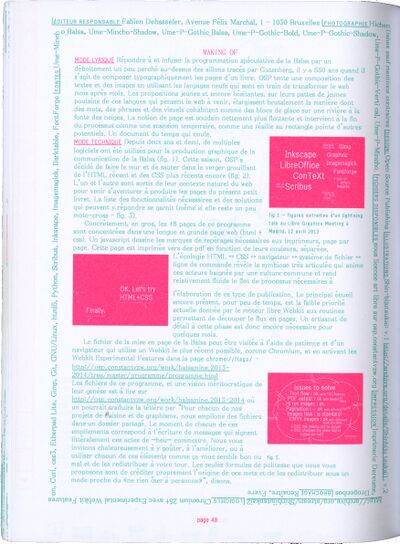The making of Balsa 2013-2014 (EN)
This is an English translation of the Making of text published in the Balsamine program booklet 2013-2014, written by OSP. Translated in August 2023 by Manetta Berends. The source files and documentation of this program booklet can be found at: http://osp.kitchen/work/balsamine.2013-2014/.
Responding to and infusing the Balsa's speculative programming with a dislocation slightly perched above the furrows traced by Gutenberg 550 years ago when it came to typographically composing the pages of a book. OSP attempts to compose texts and images using the new languages that are transforming the web month after month. The young and still hesitant proposals, on their feet as the young foals of these languages that are thinking of the web to come, brutally broaden the way in which words, sentences and images live together like blocks of ice on a river as the snow melts. The notion of the page is suddenly much more buoyant, and at the end of the process intervenes like a temporary scansion, like a mesh in the rectangle pointing to other potentials. A document of the passage of time.
Over the last two and a half years, a wide range of software has been used to produce the graphics for La Balsa's communications (fig. 1). This season, OSP has decided to take the plunge and jump into the teeming orchard of recent HTML and even more recent CSS (fig. 2). Both have been taken out of their natural web context to venture into the production of the pages in this little booklet. The list of functionalities required and the solutions that can meet them is growing (even if it remains a little motocross - fig. 3). Basically, the 48 pages of this programme booklet are concentrated in a long, large web page (html + css). A javascript script draws the registration marks needed by printers, page by page. This page is printed to PDF's and separated according to their colours. The HTML ↔ CSS ↔ browser ↔ file system ↔ command line ecology reveals the highly articulated symbiosis that animates these players bathed in a common culture and makes the flow of processes required to produce this type of publication relatively fluid. The main stumbling block that remains, for the foreseeable future, is the low priority currently given by the Webkit open-source engine to routines enabling the stream to be broken down into pages. Some fine-tuning at this stage is therefore still necessary for a few months.
The Balsa layout file can be visited with patience and a browser that uses the most recent Webkit possible, such as Chromium, and by activating the Webkit Experimental Features at the chrome://flags page.
